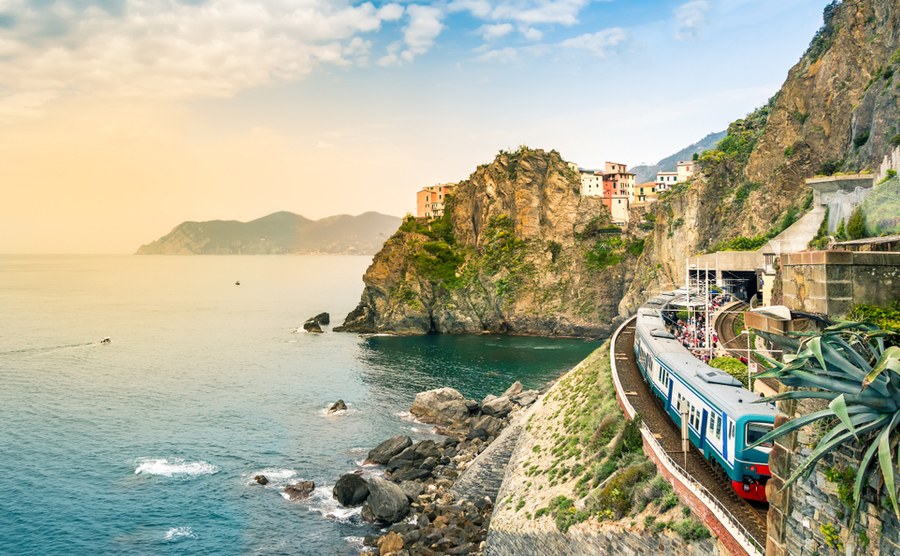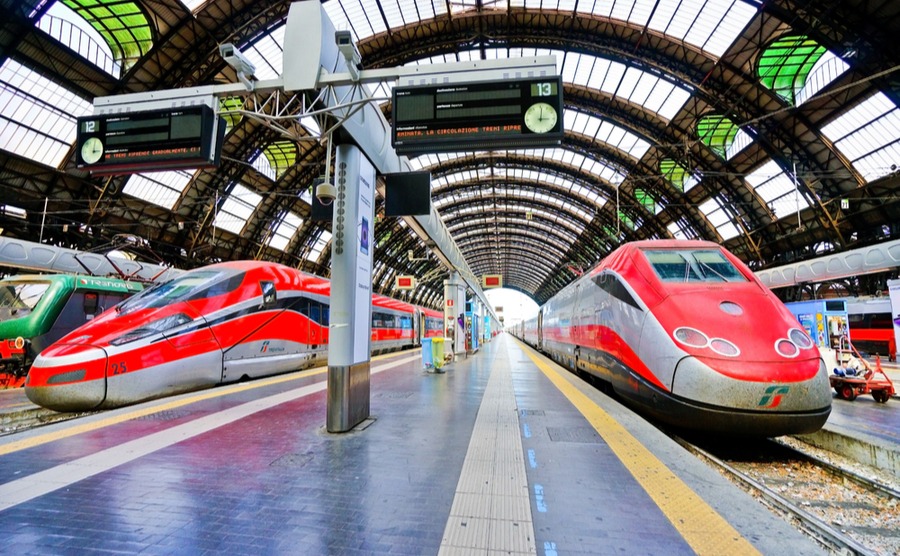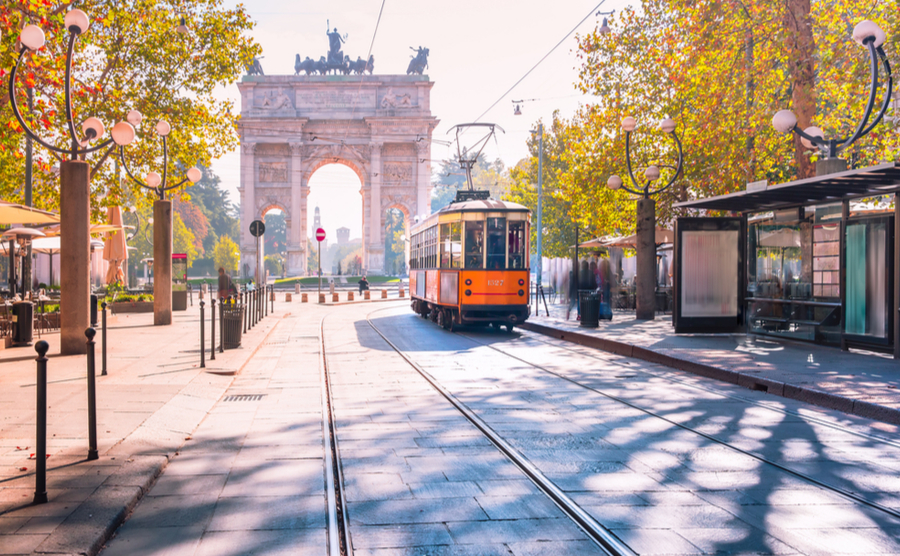Out of the way regions of Italy are getting more accessible for home buyers due to a huge extension to Italian train services. As well as a greener, cleaner choice, being able to travel by train avoids the need for outrageous car hire charges, says expat train fan Julia.
An increase in summer trains to villages and popular Italian regions, means holiday home buyers now have more destination choices. For those who don’t want to spend their holidays driving, or run to the expense of car hire on every trip, it can be very convenient to choose a location near a train station, especially on a line connected to an airport.
Find homes in Italy via our property portal.
Italy’s tourist hot spots, such as Venice and the Amalfi Coast, have become increasingly crowded, as tourists from around the world flock to get a taste of “la dolce Vita”. In 2022, Italy saw around 56 million arrivals. In 2023, that figure is predicted to reach 75 million.

A train on the Cinque Terre coast
Therefore, visitors are now being encouraged to take the train and visit places outside the well-worn tourist routes. Italy has many beautiful towns and villages that in the past have been overlooked by travellers, due to poor transport links and little online marketing. However, in recent years roads, flights, buses and trains have improved enormously. Creating greater interest in less well known, yet equally amazing locations.
Italy has many beautiful towns and villages that have been overlooked by travellers, due to poor transport links
For example, you can fly to Bari airport in Puglia, where an internal walkway takes you from the terminal to the train platform. A modern electric train takes you to Bari train station, where you can catch a train along the coast, calling at lovely seaside towns such as Mola di Bari, Polignano a mare, Monopoli, Fasano, Ostuni and Brindisi. The journey to Polignano a mare can cost as little €8.
An increase in trains and special offers have already begun this summer, with more exciting developments planned for 2024.
More trains for Summer 2023
This summer there have been more trains to summer holiday destinations, with over 250 Frecce running on the Italian railway network per day, offering over 120,000 seats. They travel to more than a hundred and twenty seaside destinations, mountain locations or cities of art.
To meet the growing demand, significant investments have been made in new trains and buses, and their frequency has been increased, especially at weekends. For the summer, more services were provided to those regions that are particularly good for holidays. Especially, Piedmont, Friuli Venezia-Giulia, Lazio, Campania, Puglia, Sicily and Sardinia.
Combining transport
New integrated travel solutions have been introduced incorporating train, bus, ship and plane. It is now easier for travellers to plan their whole journey. On trainline.com https://www.thetrainline.com/ you can search for a journey from say, Pisa airport to Barga, and it will show train connections and buses.
Digital booking
The number of tickets purchased on digital channels is growing, up 80% compared to 2019. Travel planning is now easier thanks to the renewed Trenitalia app, which will allow you to easily purchase train and bus tickets from your phone.

Would you want to take your dog with you on the train?
Take your dog
To help dog owners who want to take their pets on holiday with them, the dog’s ticket is free on Frecce and Intercity trains up until 15th September 2023. After that a ticket for your dog will cost €5 Sunday to Friday, and only €1 to travel on Saturday.
Special promotions
This summer Trenitalia have been offering amazing discounts on train tickets for those aged under 30 or over 60, and family groups. You can also get a discount on a day return ticket, which is great when you want to make a day trip to one of the big towns, but prefer to have a property somewhere quieter.

Milan Central Station (Yulia Khardina / Shutterstock.com)
Fast trains from Milan
The connections to the south between Milan and Naples have also increased, with a total of 68 Frecciarossa trains per day and over 30,000 seats offered. Once in Naples you can easily travel on to the Amalfi coast and Pompeii. In addition, the route from Milan to Rome has four more Frecciarossa trains a day, with a total of 94 daily connections, and an average frequency of about one train every 15 minutes at peak times.
Taking your bike on the train in Italy
More and more people are now wanting to take their bike on the train, with a growing number of holidaymakers choosing to cycle during their holidays. Bookings for bikes are said to have increased by 30% compared to 2022. Regional, intercity and Eurocity trains have responded by increasing the number of bike spaces to around 26,000. Having the option to jump on a train with the bike, opens up many more opportunities to explore a wider area.
In fact, you can take your bike on any train in Italy at no extra cost. Although, this is only if it is a folding bike or a traditional bike that you have dismantled (eg, removed a wheel). Basically, it must fit in the luggage racks provided. However, this option doesn’t require a reservation.

Famous vintage tram in the centre of the Old Town of Milan in the sunny day, Lombardia, Italy.
Vintage trains calling at villages
If you love old trains and Italian villages, look out for the new FS routes by ‘treni storici’ (vintage trains), coming in 2024. These will focus on areas of historic and scenic interest, with some possibilities to stop for guided tours, walks and tastings along the way. You’ll be able to explore popular tourist destinations and less well known villages on vintage trains. This is part of an initiative by Italy’s state owned railway operator Ferrovie dello Stato Italiane (FS) to encourage visitors to see the country more sustainably.
Information on historic train journeys in Italy can be found on the Fondazione FS website. They include itinaries that travel through Tropea in Calabria, Ragusa in Sicily, and Roccaraso in Abruzzo.
Orient Express
If you want to treat yourself to a bit of luxury, FS Treni Turistici Italiani is launching a new Orient Express La Dolce Vita service. This luxury train is inspired by the famed Orient Express rail service that transported passengers across Europe from 1883 until 1977. It will cross Italy from north to south on six routes, stopping at new Orient Express branded hotels in Rome and Venice along the way.
The train will accommodate up to 62 guests across 30 cabin suites. With suites for two people ranging from €6,600 euros to €25,000 euros per night. Even before work on the train is finished, wealthy individuals have already preregistered for 2024.
Launching in 2024, FS Treni Turistici Italiani (Italian Tourist Trains) will offer services geared towards tourism. They are aiming for a kind of tourism where the train journey is an enjoyable part of the holiday.
Express trains
Next year, The “Espressi” (Express) will also be adding more new routes from major cities to tourist areas, such as Milan to the Ligurian and Tuscan coasts. They are also planning a night train from Rome that will stop at Otranto in Puglia and Metaponto in Basilicata, before heading around the Ionian coast.
The Express trains will use rolling stock from the 1980s and 1990s, refurbished to offer 21st-century extras such as restaurant cars, sleeper cabins, and storage areas for bicycles and skis. Services will follow seasonal tourism trends.
Their seasonal routes will include Milan to San Candido on the Austrian border; Milan to Livorno, Genoa, and Ventimiglia (close to the French border)
Omnibus–Regionali
Finally, the ‘Omnibus-Regionali’ weekend services will provide slower regional trains at cheap prices. The routes will be planned with tourists in mind, calling at scenic villages rich in history, food and wine traditions. It is hoped the new train routes will give these less well known villages an economic boost, when passengers spend money in their shops and cafes.
Types of train in Italy
Alto Velocita – high speed trains, run by Trenitalia. They run on a completely different kind of track than other trains in Italy. There are three types of AV train. They are:
- Frecciarossa – The “red arrow” trains, reaching speeds of more than 223 miles per hour (360 km/hr), serving Turin, Milan, Bologna, Rome, Naples, and Salerno.
- Frecciargente – The “silver arrow” trains, reaching speeds of more than 155 miles per hour (250 km/hr), serving Rome, Venice, Verona, Bari/Lecce, and Lamezia Terme/Reggio Calabria.
- Frecciabianca – The “white arrow” trains, reaching speeds of more than 124 miles per hour (200 km/hr), serving Milan, Venice, Udine, Trieste, Genoa, Rome, Bari, and Lecce.
Italo – operated by the NTV company. So far, Italo trains serve Milan, Venice, Padua, Rimini, Bologna, Pesaro, Ancona, Florence, Turin, Rome, Salerno, and Naples. They are competitively priced with the AV trains if booked in advance.
Eurostar Italia (ES) – This is not the same as the trains that connect London to Paris and Brussels. The Italian Eurostar was the fastest thing in Italy until the AV trains came along. ES train tickets typically cost less than tickets for AV or Italo trains.
Intercity trains (IC) –InterCity trains also cover long distances in Italy, but are slower and cheaper.
Regional trains
There are several varieties of regional trains in Italy, including the InterRegionale (IR), Regionale (R), Diretto (D), and Espresso (E). They’re much slower than the trains listed above and make lots of stops, which also means they’re much cheaper. They are handy for short journeys along the coast or between small towns and villages.
Read more in this article, six suggested villages you can reach by train.










